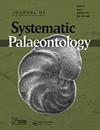The fossil record of sabre-tooth characins (Teleostei: Characiformes: Cynodontinae), their phylogenetic relationships and palaeobiogeographical implications
IF 2.2
2区 地球科学
Q3 EVOLUTIONARY BIOLOGY
引用次数: 1
Abstract
The family Cynodontidae is composed of freshwater fishes inhabiting drainages east of the Andes in South America. Its fossil record is mostly represented by isolated teeth that are difficult to identify. Here we describe fossil cranial remains of the extant species Hydrolycus scomberoides as well as isolated teeth that were identified as Hydrolycus and cf. Rhaphiodon in sediments of the late Pliocene Ware Formation in the Guajira Peninsula, west of the Andes. Novel, phylogenetically informative characters were found including the number of symphysial teeth, the plane of insertion of the leading teeth onto the dentary, the presence of accessory posterior dentigerous patches, and depressions and outline of the dentary. We performed a phylogenetic analysis combining morphological and molecular characters including both extant and extinct specimens, producing a well-resolved topology that recovers a novel sister-group relationship between the genera Hydrolycus and Cynodon, while the genus Rhaphiodon falls to the base of this clade. This contradicts earlier studies recovering Hydrolycus and Rhaphiodon as sister taxa. The phylogenetic position of Hydrolycus wallacei was found to be unstable. The occurrence of H. scomberoides in the late Pliocene of Guajira is a puzzle that could be explained by different mechanisms, including a persistent drainage connection across the Andes during the late Pliocene, and/or the result of severe drying and subsequent extinction.剑齿特征的化石记录(直骨目:特征:犬齿科)、系统发育关系及其古地理意义
犬齿鱼科是由栖息在南美洲安第斯山脉以东流域的淡水鱼组成。其化石记录主要以难以识别的孤立牙齿为代表。在这里,我们描述了现存物种Hydrolycus scomberoides的头骨化石,以及在安第斯山脉以西的瓜希拉半岛上新世晚期陶器形成的沉积物中被鉴定为Hydrolycs和Rhaphiodon的孤立牙齿。发现了新的、系统发育信息丰富的特征,包括联合牙齿的数量、前牙插入牙齿的平面、副后齿补片的存在以及牙齿的凹陷和轮廓。我们结合形态学和分子特征进行了系统发育分析,包括现存和已灭绝的标本,产生了一个解析良好的拓扑结构,恢复了Hydrolycus属和犬齿龙属之间的新姐妹群关系,而Rhaphiodon属属于该支序的基础。这与早期将Hydrolycus和Rhaphiodon作为姐妹类群的研究相矛盾。wallacei水解菌的系统发育位置不稳定。瓜希拉上新世晚期scomberoides的出现是一个谜,可以用不同的机制来解释,包括上新世晚期安第斯山脉的持续排水连接,和/或严重干旱和随后灭绝的结果。
本文章由计算机程序翻译,如有差异,请以英文原文为准。
求助全文
约1分钟内获得全文
求助全文
来源期刊
CiteScore
5.30
自引率
7.70%
发文量
31
审稿时长
>12 weeks
期刊介绍:
The Journal of Systematic Palaeontology publishes papers that provide novel and impactful results in phylogenetics and systematics and that use these results in ways that significantly advance rigorous analyses of palaeogeography, palaeobiology, functional morphology, palaeoecology or biostratigraphy. Papers dealing with theoretical issues or molecular phylogenetics are also considered if they are of relevance to palaeo-systematists. Contributions that include substantial anatomical descriptions, descriptions of new taxa or taxonomic revisions are welcome, but must also include a substantial systematics component, such as a new phylogeny or a revised higher-level classification. Papers dealing primarily with alpha-taxonomic descriptions, the presentation of new faunal/floristic records or minor revisions to species- or genus-level classifications do not fall within the remit of the journal.

 求助内容:
求助内容: 应助结果提醒方式:
应助结果提醒方式:


